8 Proven Techniques to Improve Your Website Visibility
Editor’s Note: This post was originally published in July of 2023 and has been updated in March 2025 for accuracy and comprehensiveness.
Website visibility is measured by the rate at which a website is discoverable on digital channels (search engines, social media platforms, etc.) whenever users conduct a search query.
Although Google still holds the largest share of the search engine, AI-driven platforms like Google AI Overview (AIO), Perplexity AI, and ChatGPT are becoming the go-to sources for information.
Take Google AI Overview, for example. Whenever a user runs a search query, they get the information they need without clicking through a website. These overviews are displayed before the organic search results, with links to the reference websites on the right, like this:
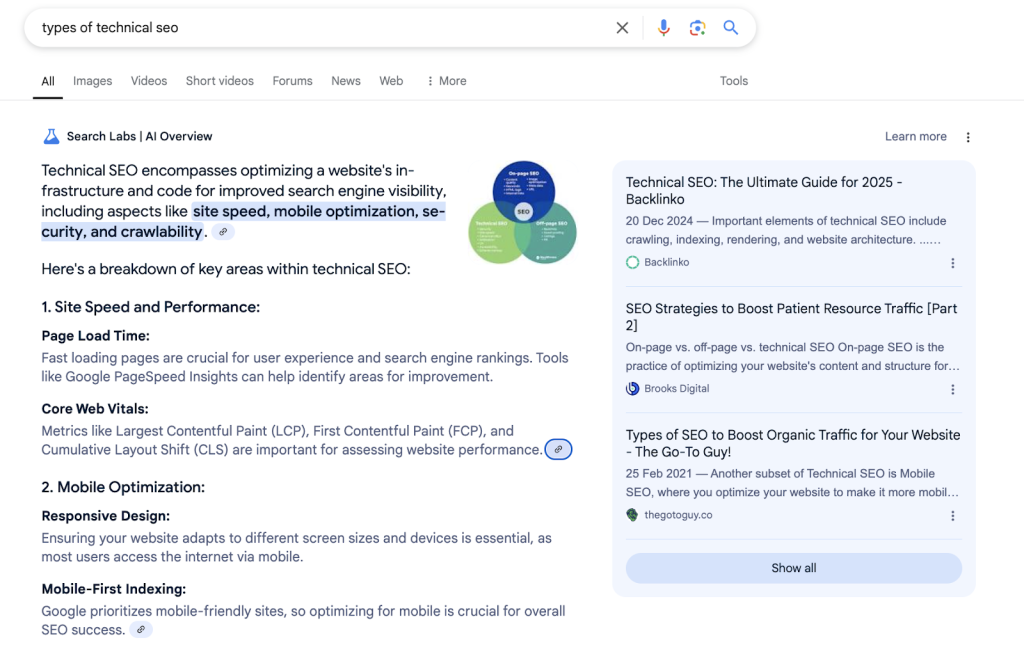
What does this mean for your business?
The AI Overview is the first thing users see on the search results, even before featured snippets. It’s an opportunity to increase your digital footprint and attract quality traffic to your website.
Luckily, you don’t have to rank on the first page to appear in AI Overviews. While this is helpful, only 52% of AIO sources are from pages that are ranked in the top 10 of the search engine results pages (SERPs). In this article, I’ll show you how to improve your website visibility on traditional search engines (Google, Bing) and AI platforms.
8 Tips to Improve Website Visibility in 2025
Here are some of the strategies you should focus on in 2025:
1. Optimize for The Right Keywords to Appear in Relevant Searches:
Keyword research is the foundation to any effective SEO campaign. It lets you know what your audience is searching for so you can optimize for them and attract relevant traffic to your website.
How to conduct keyword research?
- Start with customer research. Who are your customers, and what are they searching for online? What search terms/phrases do they use? This will give you an idea of their interests and pain points.
For better insight, speak to your target audience. They can be people in your community, your workplace, or on your social media platform.
Ask for how they search for the pain point your product addresses and if they’ll pay for a product like yours. The more people you talk to, the better.
- Decide which topics you want to be known for. This is (very) important because LLMs rely on topical authority to generate responses. You can use Google Forms to conduct a survey or find content ideas on forums like Reddit and Quora:

Other research tools, like Answer the Public, converges the questions and phrases your customers are searching for on Google (long-tail keywords):
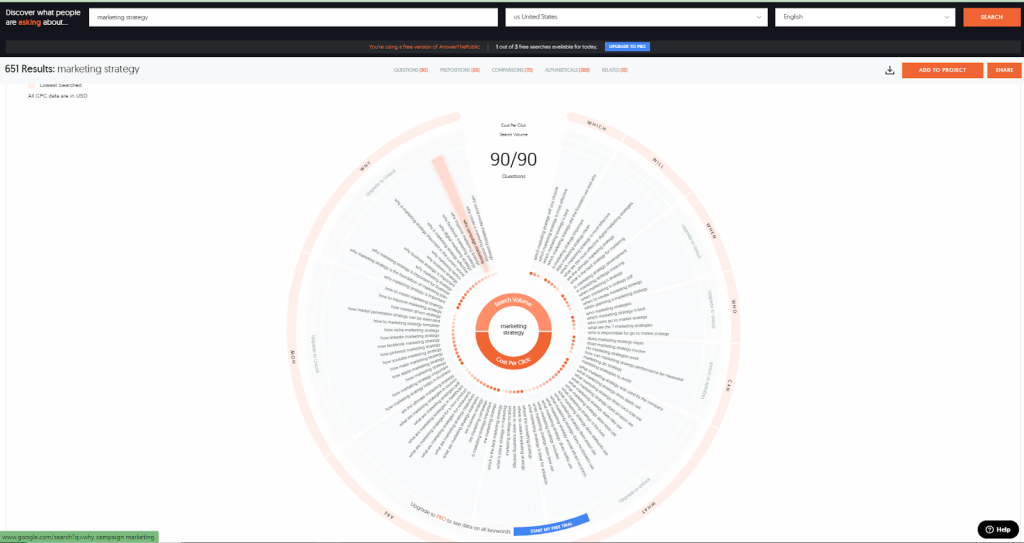
You can also use LLMs for follow-up questions and keyword ideas based on what users are searching for on their platforms. For example, if you insert a keyword into Perplexity AI, you’ll get a drop-down of related searches:
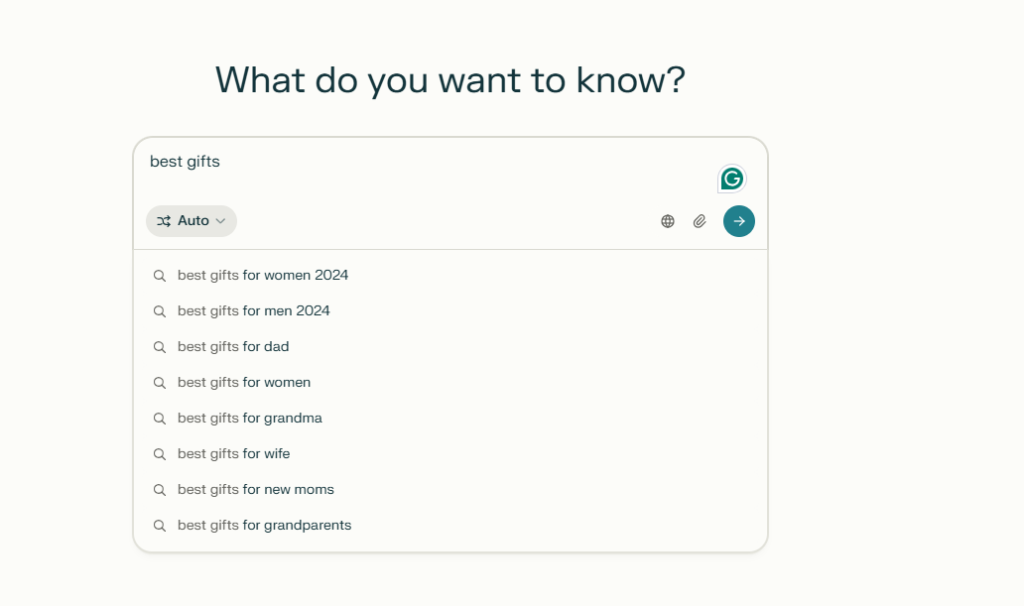
And follow-up questions users ask:

Ross Simmonds, CEO of Foundation INC, shares other helpful sources to get keyword ideas:

- Next, use SEO tools like Google Keyword Planner, Moz Keyword Explorer, Ahrefs, etc., to analyze the keywords. Look out for specifics like the search volume, keyword density, and cost per click (CPC):

Ahrefs, for instance, comes with a SERP feature that allows you to filter keywords to rank on AI Overview:

Tip: Instead of looking for keywords with the highest search volume, focus on quality, i.e., high-value, long-tail keywords. Adam Heitzman, co-founder of HigherVisibility, adds more insights to this:
“Personally, I look at several items: business relevance, search volume, traffic potential, keyword difficulty, keyword value (conversion potential). I use Keyword Value Index to evaluate these keywords to find the ones to prioritize. So how exactly do you calculate it? Keyword Value Index = Search Volume * CPC/Difficulty.”
We have an article that covers this topic in detail. You can read it here.
Next, optimize your website content with the keywords:
Content optimization makes your website discoverable and readable by humans and search engines.
Read on to find out how to do this:
2. Optimize Your Pages with Necessary Keywords to Improve Your SEO:
On-page SEO is the process of optimizing your webpages to improve search and user experience. It covers activities like:
- Using relevant meta tags.
- Creating quality, user-centric content.
- Improving user experience.
- Improving website architecture, etc
I love how Teri Clapper explains how to perform on-page optimization to increase website visibility in her episode on the Smarter Marketing Podcast:
“The first and most crucial element of on-page optimization is your keyword use. Conduct thorough keyword research that aligns with your business and target audience…You need to have one keyphrase per page. Incorporate them in strategic places like the page title, meta description, headings, and content.”
Let’s cover the main on-page SEO tasks in detail:
Meta tags and descriptions
Meta tags are snippets of HTML code that provide information about your web page to search engines:

They act as a summary of your web page, and it’s the first thing users see on the search results:

If it’s not compelling enough, the searchers will ignore your website, which is why it’s important.
Here are some best practices:
- Add the primary keyword in title tags and meta descriptions to incite click-throughs on SERPs:

- Keep the length of your meta description around 105 characters.
- Address your audience’s pain points. More importantly, your meta tags should be concise yet informative:
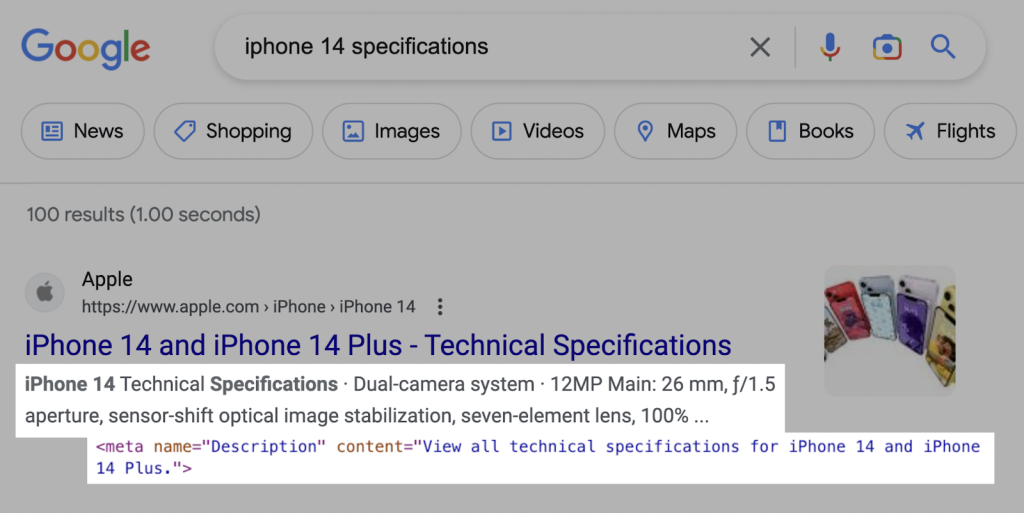
Target long-tail keywords for better visibility
Long-tail keywords are longer and more specific queries with low search volume. However, they have high search intent, low competition and are easier to rank for:

For example, if you’re a marketing agency, short-tail keywords like “marketing” are competitive to rank for because of their high difficulty score. Over 10 billion pages are listed on the search results for this keyword:

However, you can target more specific, long-tail keywords like “Top 10 Affordable Marketing Agencies for small business” and dominate the search results for it:

Improve website architecture through internal linking and headings
A well-structured website helps Google bots and users understand how to navigate your website. You can improve your website architecture in two ways:
- Add internal links.
- Heading optimization.
Internal links show the relationship between website pages. They also:
- Distribute link equity.
- Guide visitors to other related content to keep them engaged.
- Help search engines discover new website pages.
Headings, on the other hand, organizes your content and help Google index it better on the search results. Technically, your web page headings should look like this:
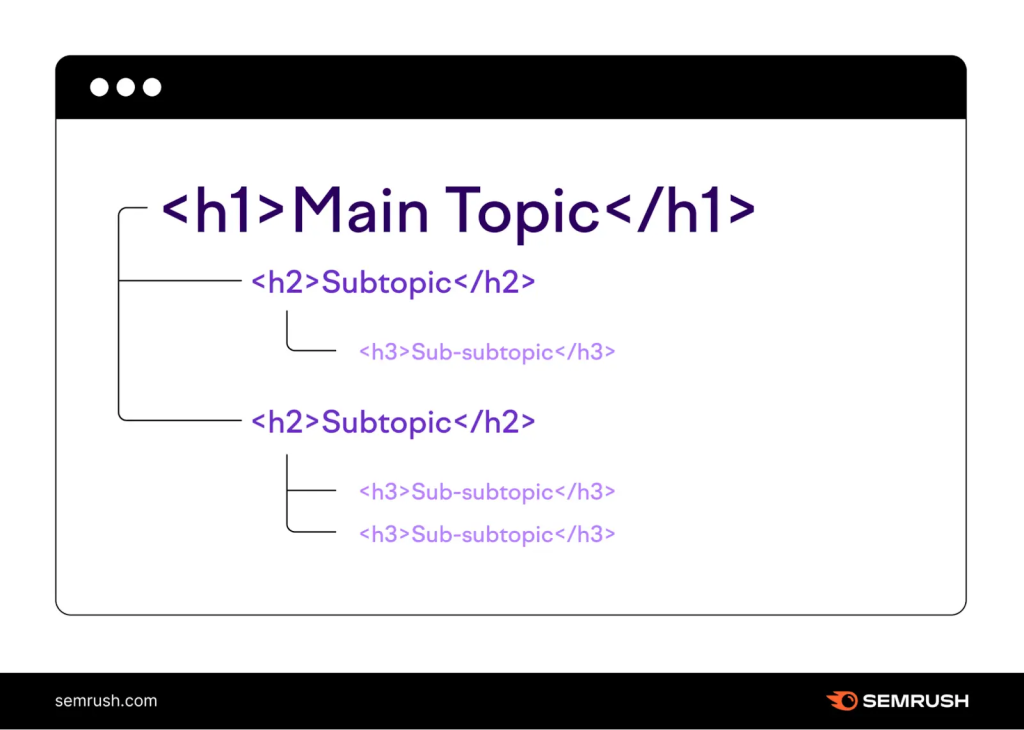
Other helpful on-page SEO tips are:
- Add keyword-relevant and descriptive alt-text to your images. For example, instead of “dog,” use “rottweiler playing with a red ball in the park.” This helps to improve your website accessibility and rankings on visual searches
- Use a reliable hosting provider and Content Delivery Network (CDN) to reduce latency.
- Use internal links at the top of your page. Ideally, it should be within the first 100 words of your web content.
- Minify HTML, CSS, and JavaScript files.
- Optimize your website for Google’s core web vitals.
- Use keyword-rich anchor texts in your web content.
3. Publish High-Quality Content that Meets User Intent
In this AI-driven age, you need high-quality content to:
- Appear on search engines and AI-related searches.
- Attract quality traffic to your website.
- Nurture your website visitors until they become loyal, paying customers.
High-quality content is:
- Informative.
- Scannable.
- Engaging.
- Optimized for SEO.
- Relatable, i.e., meets user intent.
Mordy Oberstein, Head of SEO at Wix, says:
“…if you can create content that resonates with your audience, there’s huge value in that. And yes, the ecosystem as a whole might be changing, but that doesn’t take away from the value of creating written content that resonates.”
You also need to factor in Google’s EEAT (Experience, Expertise, Authoritativeness and Trustworthiness) guidelines. In one word, your content needs to be “authentic.” Here’s an example from Google:

Here are some tips to help you get started:
Be Customer-Focused:
Wendy Covey, CEO of TREM Marketing, shared (via Forbes) an effective way to build a customer-centric content strategy:
“Start with interviewing your customers. Find a small number that best represents each audience persona you intend to target. During a brief interview, listen closely to the words each customer uses to describe why they chose your company’s solutions and how it has impacted their business and professional success.
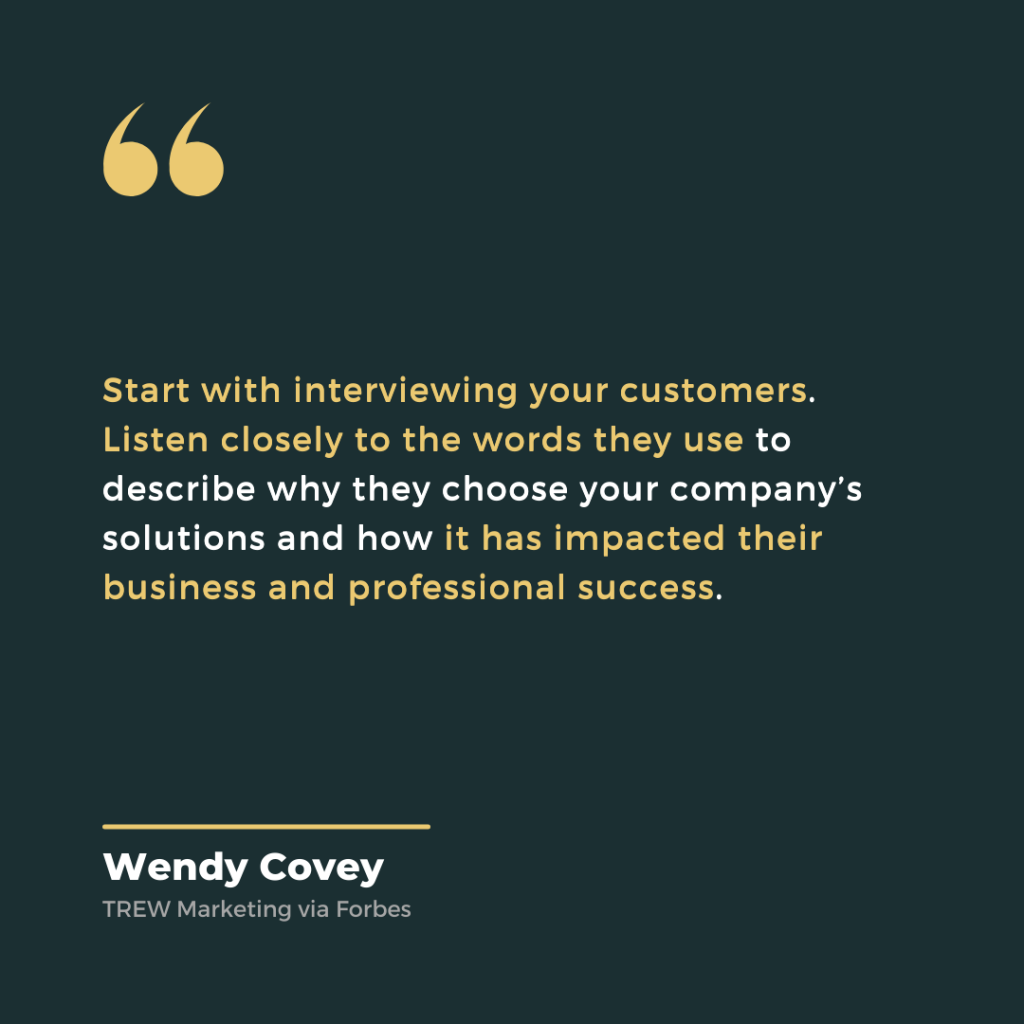
Write compelling headlines and intros:
Headlines and intro make the first impression on a reader, and it’s only imperative you make it count.
The rule of thumb is to be concise, and compelling. Your headlines and intro should answer the question, ”What is in this for me?” like this:

This intro is specific, shows expertise by referencing Steve Jobs, and naturally incites the reader to dig deeper.
Some best practices to adopt are:
- Keep your intros and headlines short, at most three paragraphs:

- Use a quote from a thought leader in the industry:
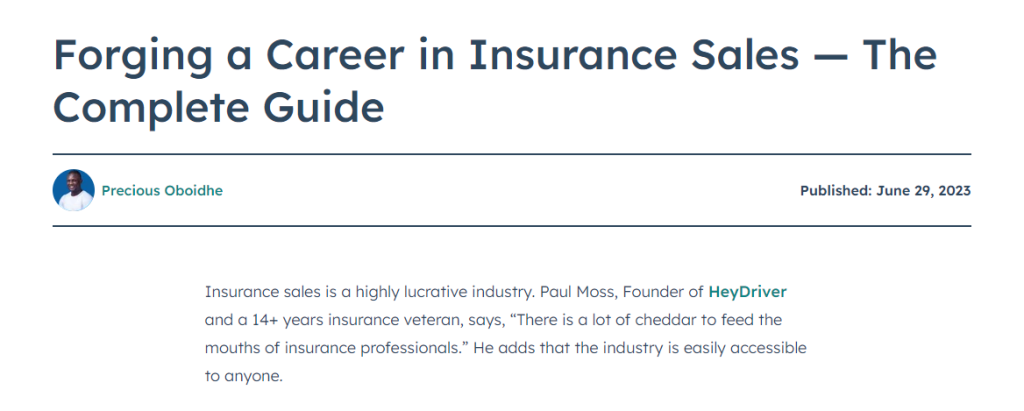
- For your headlines, use numbers to increase CTR. For example, ”7 Best Strategies for Turning Web Visitors to Paying Customers.”
Learn more about how to write compelling headlines and intros.
Structure content for readability and SEO
Content structure affects user experience and how search engine bots crawl your site. Here’s how to structure your content for readability:
- Create topic clusters to link pages.
- Use bullets to break up texts. This makes it easier to read and skim.
- Bolden vital information to improve readability.
- Add relevant keywords in headings and other strategic areas of your content.
- Use internal links to distribute link equity across pages.
Add an “Author” section to show expertise.
According to Google, it’s not enough to create content. You also need to show “who” authored it. An author’s section helps you show their expertise, build trust with your audience and signal to Google that your website content is credible.
For instance, this blog on our website shows the author, Adam Heitzman:

On the back end, he has a rich digital footprint showing expertise and experience in SEO, including references from top marketing blogs like Search Engine Journal:
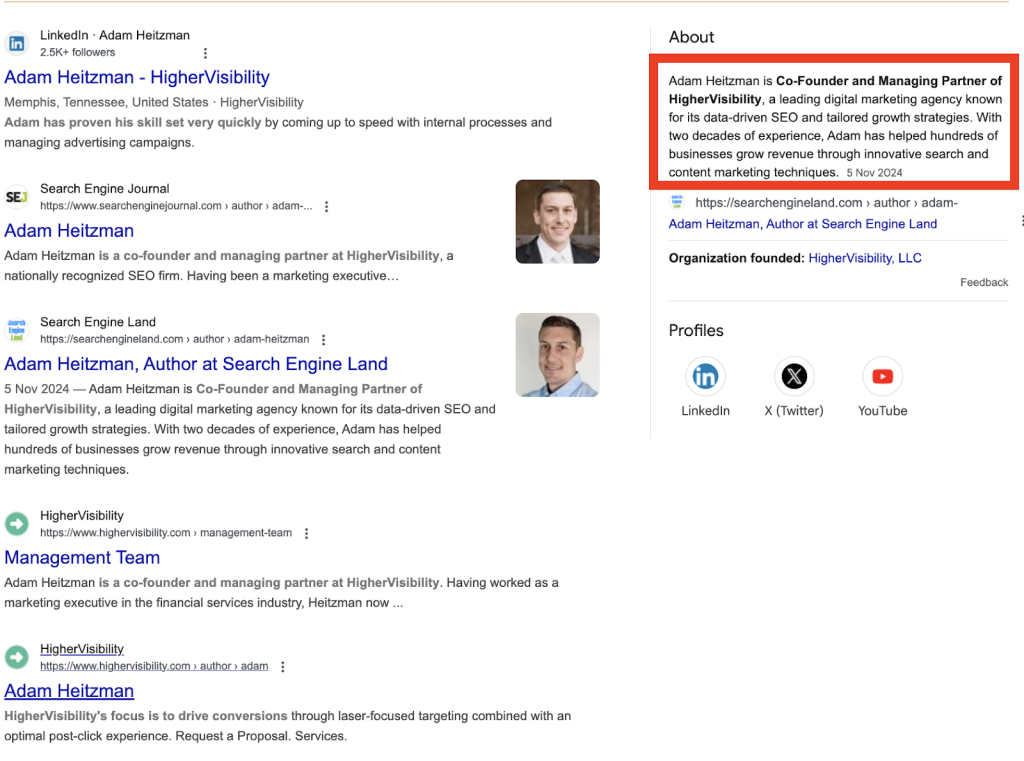
It’s not hard to see why the article tops the search results for its primary keyword:
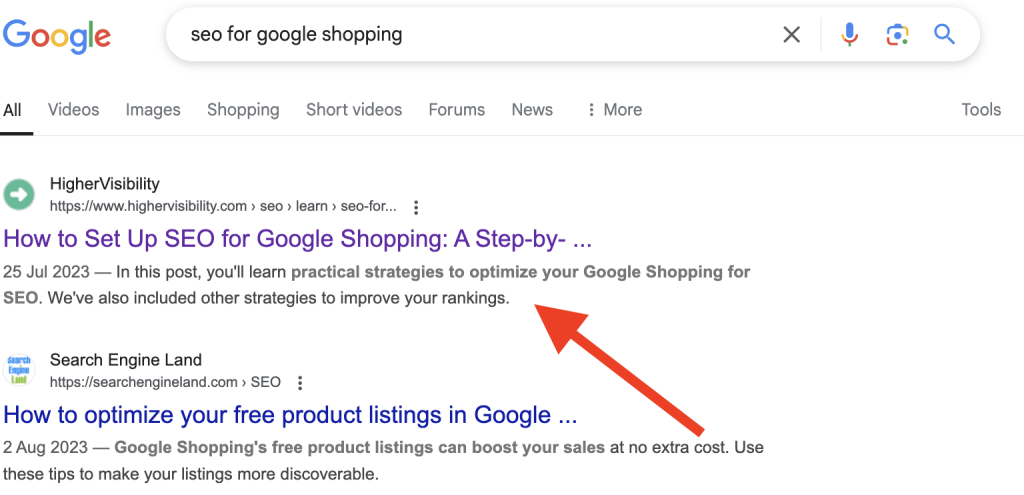
The same applies to Ahrefs:
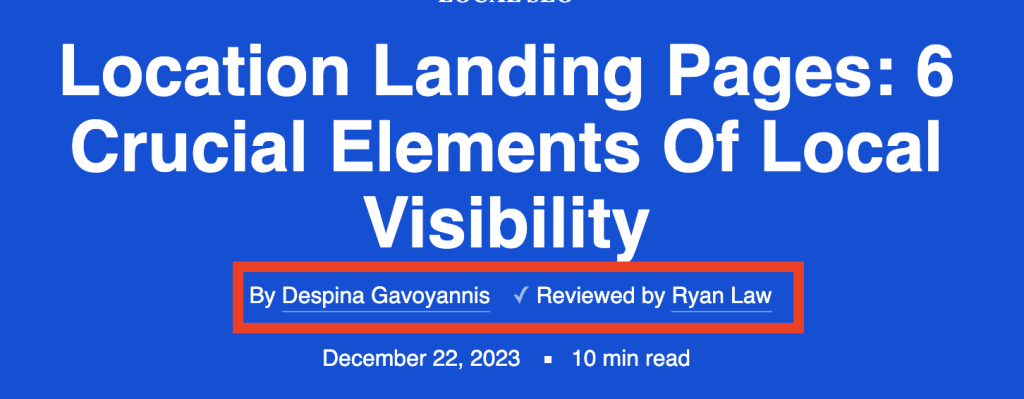
Add context to your articles to rank for AI Overview and LLM searches:
SurferSEO evaluated over 400, 000 AIOs and discovered that only 5.4% contain the exact query. This means, 94.6% of AIOs are based on content relevance or context instead of keywords.
For example, a search for “Best month to visit Chicago” shows results for the “best time”:

Adam recommends using the “Answer Engine Optimization” Strategy in your content to cover all related topics. In his words:
“Structure your content to answer questions fully, and incorporate related topics naturally. Use tools like Google Autocomplete or People Also Ask to identify common questions users have about your topic.”
You can also use schema markup to help search engines better understand what your web content is about. This way, your content can appear on rich snippets and increase your click-through rate. The rich snippets look like this:
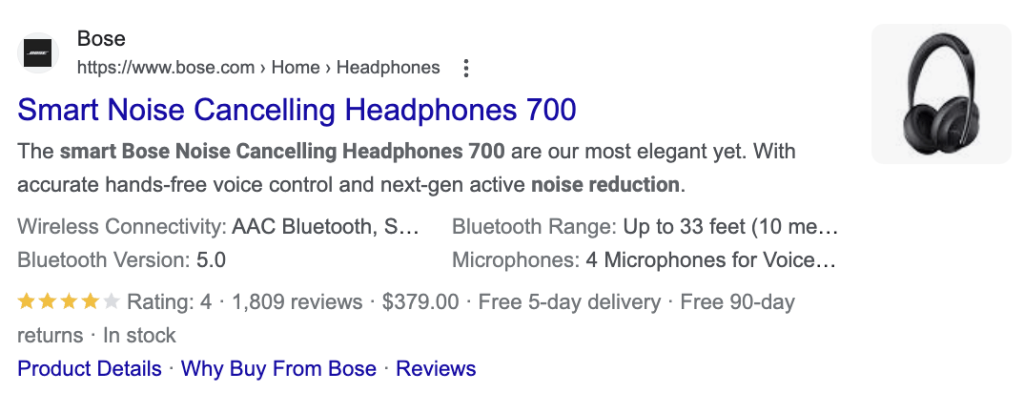
Use a product-led approach to show experience:
A product-led approach helps you demonstrate experience and expertise, especially in industries such as technology, eCommerce, or SaaS (software as a service).
Here, you can create in-depth product tutorials to show users HOW your product/service is the best solution to their problems. You can also use testimonials, case studies and other user-generated content to show authenticity and incite conversions.
4. Check for Technical SEO Issues to Improve Website Search Performance
Technical SEO helps search engines crawl and index your website to improve your search performance.
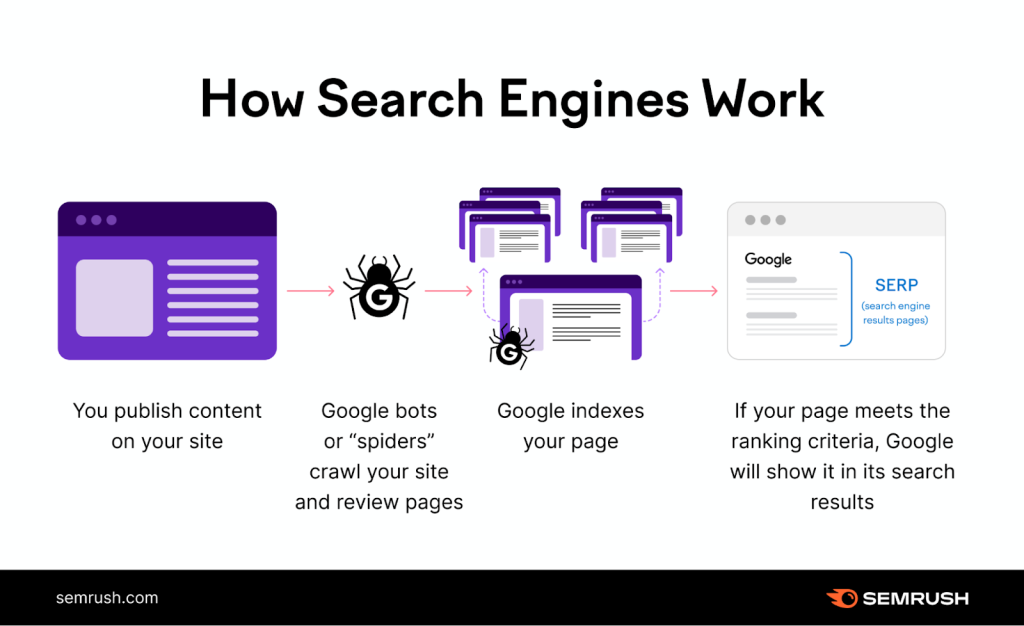
Without technical SEO, your content won’t perform well (or rank at all) on the search results – no matter how valuable it is. Examples of technical SEO tasks include:
- Page speed optimization. .
- Improving page (and website) experience.
- Fixing broken links.
- Mobile optimization.
- Security, etc.
Let’s cover the basics.
Run a technical SEO audit:
The first step is to know which areas of your website affect your search performance. Use technical SEO tools like Ahrefs, SEMRush, or Screaming Frog to run a site-wide audit to see and remedy the issues.
Improve website speed and performance
As your page speed goes from 1s to 10s, the probability of a visitor leaving your website increases by 123%, according to Google.
This means the higher your page speed, the higher your website bounce rate. On average, your page should load in 8.5s on mobile and 2.5s on desktop.
To improve your website speed:
- Choose a performance-focused hosting provider. Cloud hosting is the best option for an eCommerce store or a business that uses high-intensive applications.
- Use a content delivery network to optimize the static files such as images, fonts, etc.
- Reduce the number of HTTP requests.
- Avoid using unnecessary plugins.
- Use website caching to increase load times and reduce latency.
- Your website’s success starts with having a solid structure. Brain Dean, an SEO Expert, recommends using a flat structure to make it easier for search engine bots to crawl and index:

- Constantly audit your website to identify technical issues. SEMRush site audit tool, for example, provides further insights into your site’s technical SEO health:

Mobile optimization and responsive design
Mobile-friendly websites provide a better user experience and receive higher rankings on mobile SERPs. Plus, 59% of shoppers think mobile optimization is essential when deciding what to buy.
Tip: Use responsive design to provide a consistent user experience across devices.
Ensure your website is accessible to all users
One of the core elements of a good web design is accessibility. Website accessibility ensures that everyone can understand and use your site, including people with disabilities. To make your website accessible:
- Add alt-text with descriptions to images.
- Use headings appropriately. Structure them in a way that conveys information hierarchy.
- Provide an alternative style button to enable readers to enlarge the font without altering the style of your site.
5. Use Effective Link Building Strategies to Show Authority
Link building is the practice of acquiring backlinks to improve your website’s credibility and trust. These backlinks act as a vote of confidence and send trust signals to Google that your content is valuable and trustworthy. They can also transfer “link juice” to your website.
A high-quality backlink is:
- Relevant to your topical focus or industry.
- From an authoritative website (> 50 domain authority).
- Within the context of the page that it’s on.
- Natural.
Create Quality, Linkable Content Assets
One of the many ways to attract backlinks from reputable websites is to create high-quality, valuable, and linkable content. This can be State of [Your Industry] content, eBooks, infographics, or even thought leadership content.
Guest-Blog
Also, reach out to other authoritative websites in your industry for collaboration. You can share your expertise in exchange for a link to your website. For example, Adam’s article on SEJ links back to the HigherVisibility website:
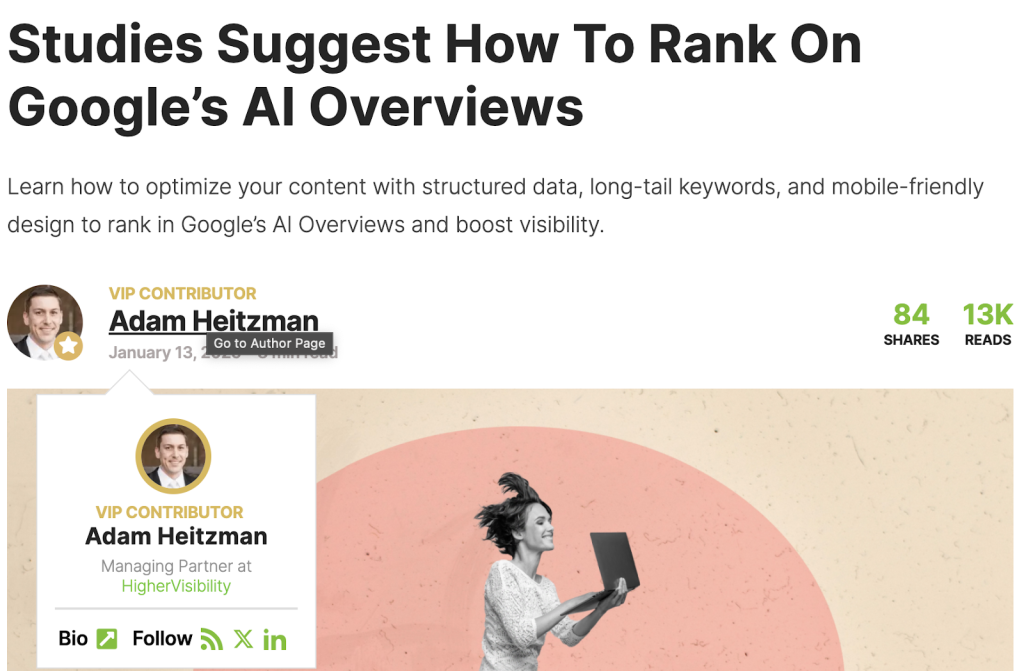
Engage in Digital PR
Digital PR is another strategy to attract high-quality backlinks and increase your digital footprint. Examples of PR platforms include HARO (Help a Reporter Out), news websites, or niche bloggers. You can offer to contribute to their stories in exchange for a backlink to your website.
6. Implement Content Distribution Strategies to Increase Digital Footprint:
Content distribution is a digital marketing strategy that entails promoting your content on various channels to increase conversions (traffic volume, lead generation, or sales).
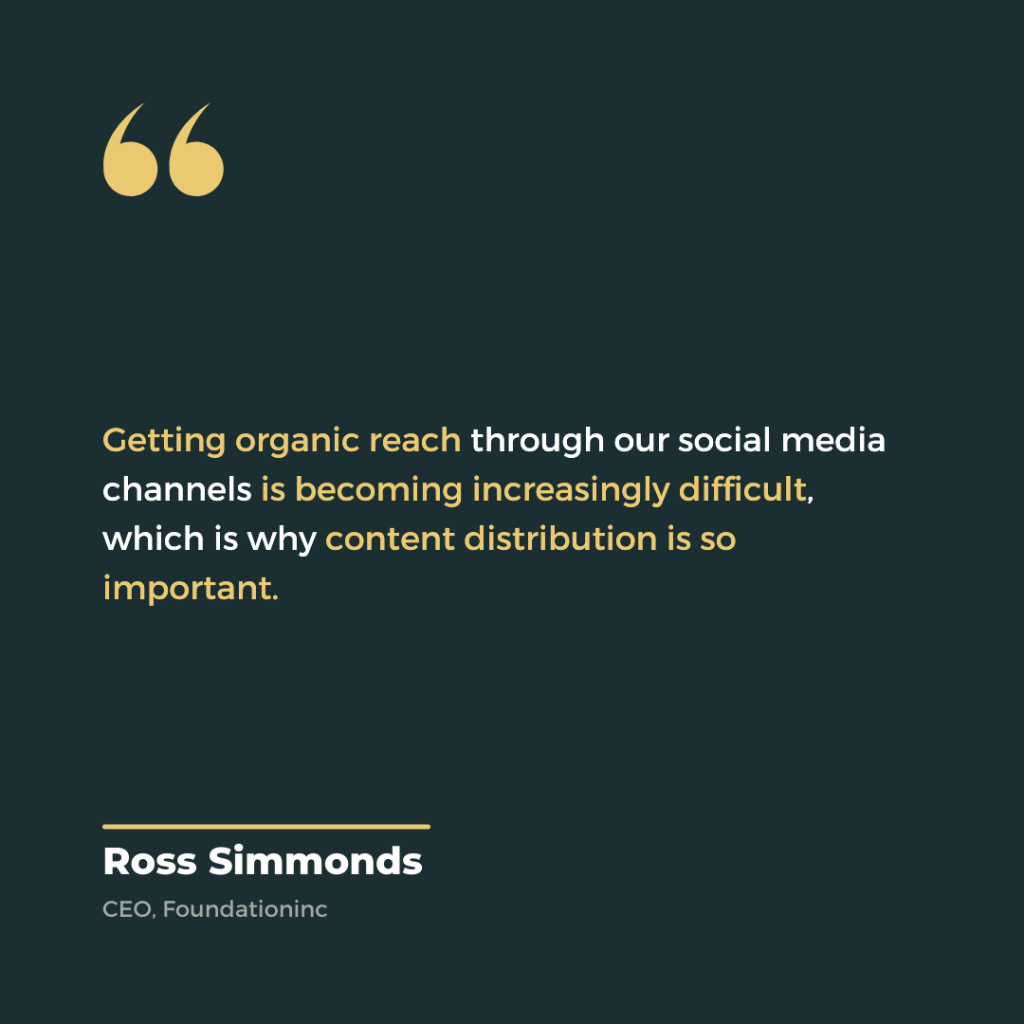
Ben Steele, senior editor of SEJ, explained why every online business needs a content distribution strategy via SEJ SEO Trends for 2025:
“ …dissatisfaction with the quality of Google Search results leads users to seek direct and curated sources of information in customized social media feeds, UGC platforms, and even email newsletters. The desire for information isn’t going away, but users are changing how they seek information. In the past, SEO pros answered questions in order to lure in users. That might still be the case, but people are finding answers outside of the SERP (or staying in the SERP) for answers rather than going to websites.”
Katie Morton, editor-in-chief of SEJ, also affirms this:
“As an SEO pro, don’t give up on content strategy, but don’t count on Google as your main source of traffic forever. It’s never been more important to focus on diversifying your traffic sources.”
So…how do you attract and convert visitors?
Use social media platforms:
Over 64% of the world’s population is active on social media. This means your potential customers are likely present on one or more platforms. The key is to find out which channel they spend the most time on and how they engage with content.
Head of SEO at Getty Images, Helen Pollitt, agrees with this. In her interview with SEJ, she shared the importance of integrating content marketing with social media marketing:
“With large language models (LLMs) and social media channels becoming more popular sources of seeking out information and brands, SEO professionals need to link up with brand and social media managers to become part of their customer journeys. Brand is increasingly important to acquisition, not just conversion. We’ll see it more over the next few years.”
To do this, conduct in-depth customer research to know the type of content they interact with. Do they engage with educational posts on LinkedIn or watch interactive videos on YouTube? This will help you understand how to create an effective social media strategy.
Also, repurpose your web content into formats specific to each platform. For example, video content is perfect for YouTube, Instagram and TikTok, while written content performs better on LinkedIn and Twitter.
Tip: Use third-party social media tools like Buffer to analyze your social media engagements. Note the best-performing content and the time when your posts get the highest engagement.
Create shareable and valuable content
Value cannot be ignored, do you agree? If your post is informative, engaging, and relatable, your audience will easily recommend or share them with their colleagues.
Matt G. Southern, senior news writer for SEJ, shares insights on how to achieve this:
“Brand marketing has become increasingly important. Websites should be creating loyal communities that seek out their content directly. How? Prioritize building topical authority rather than just answering individual questions. This approach helps establish your site as a go-to resource, encouraging users to seek out your content directly.”
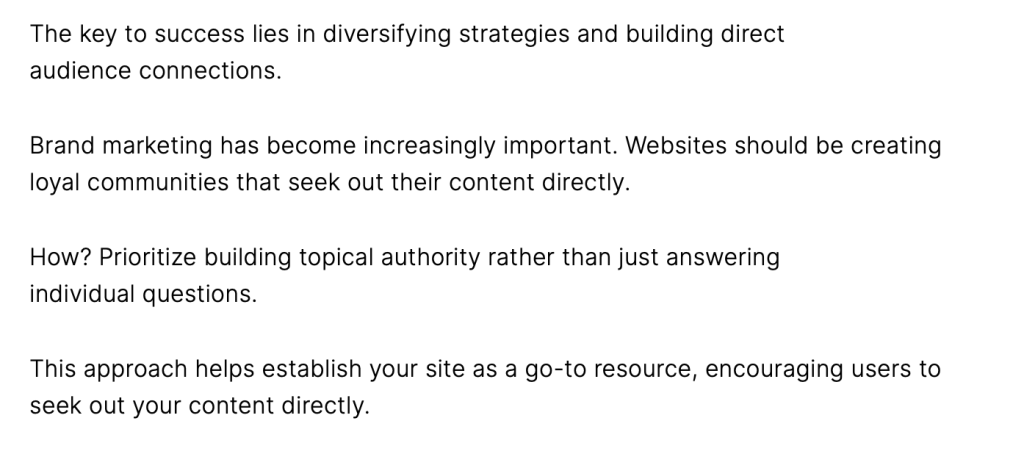
Learn how to distribute your content effectively at the right place and time.
7. Use Local SEO Techniques to Rank for “Near-Me” Searches
Local SEO is a cost-effective way to dominate the SERPs and attract qualified foot traffic. Here’s why.
- 76% of consumers who search for “near me” visit the business within a day.
- 46% of Google searches have local intent.
- 4 in 5 consumers use search engines to find information about local businesses.
Optimize for local search results
First, you need to open a Google Business Account to list your business on Google. This allows you to rank on the “golden” map pack for local queries:
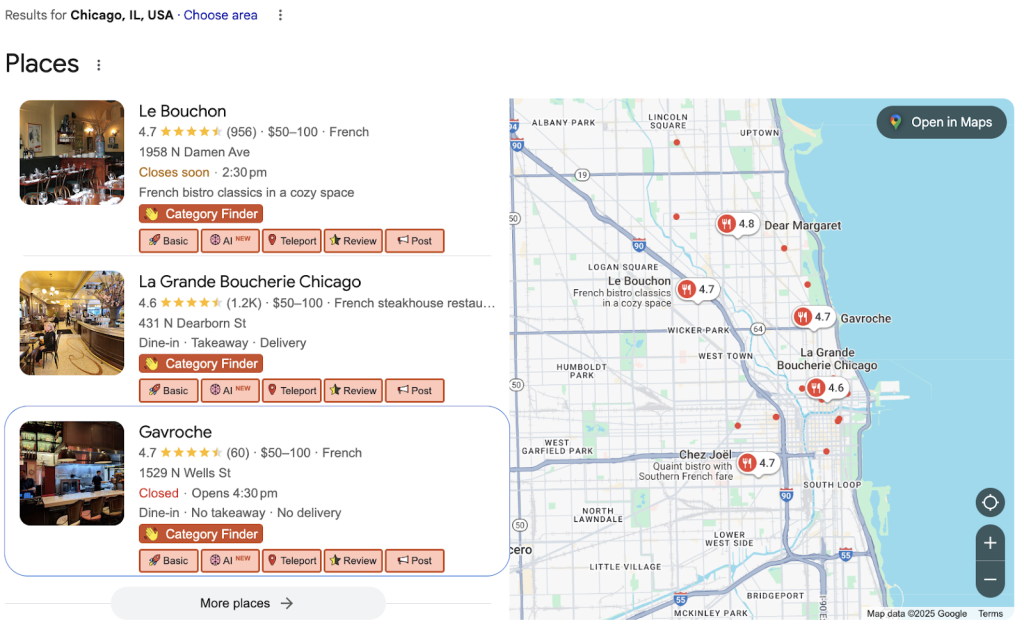
Here, you can add all the essentials about your business—products/services, contact details, address, opening hours, website, etc. We have a detailed article that covers how to rank for the local map pack. You can read it here.
Target local keywords and geo-specific content
If your business is location-specific, add local keywords in your content to appear in local searches. For example, if you run a bakery in Memphis, Tennessee, create content like “Best bakeries in Memphis,” or “where to buy fresh sourdough bread in Memphis.”
Encourage customers to leave reviews
Customer reviews are powerful marketing strategies and here’s why:
- 95% of online buyers check testimonials before making a purchase.
- 7 in 10 online customers read reviews when looking for a local business.
- 75% of consumers are concerned about fake reviews.
(Source)
Whenever you make a sale or deliver a service, ask your customers to give you a review on the review sites or local directories where your business is listed.
8. Analyze, Measure, and Improve Performance for Better Results
The SERP is constantly changing. To stay ahead of the trends and build a successful brand online, you need to analyze your campaigns constantly and improve accordingly. This means setting SMART goals and tracking the metrics relevant to your business growth.
Other strategies are:
Use automated website analytics tools
Integrate your website with analytics tools like Google Analytics or other third-party platforms. GA, for instance, gives rich qualitative insights into your website performance. You’ll see almost everything required to optimize your campaigns: site traffic, page views, bounce rates, site speed, etc.
Track keyword rankings and organic traffic
In addition, you want to see how well the keywords you’re optimizing for are performing. SEO software like SEMrush, Ahrefs, Moz, etc., gives an in-depth analysis of your SERP performance and helps you know which keywords you rank for. See this from Search Console:
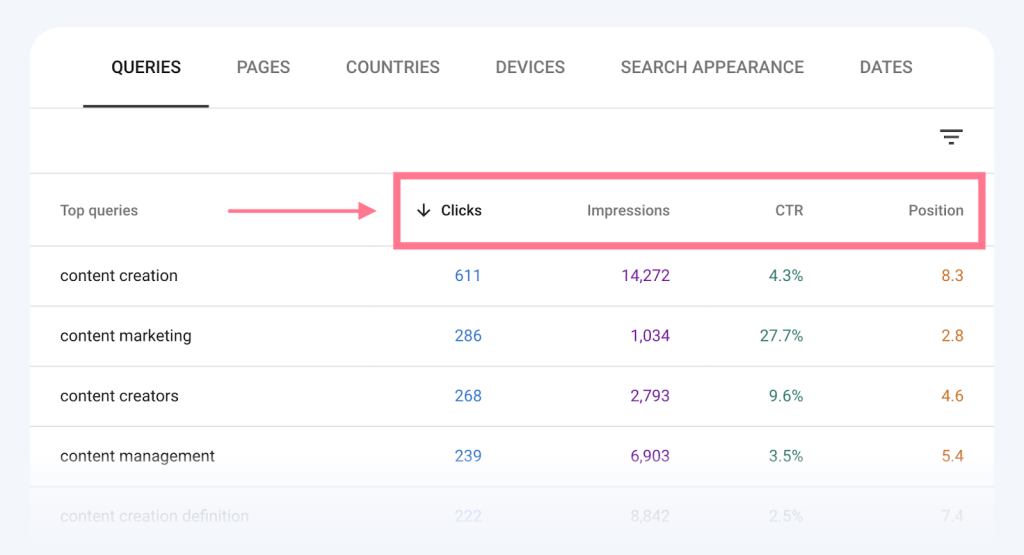
SEMRush has a competitor analysis tool to help you compare your website with your competitors:
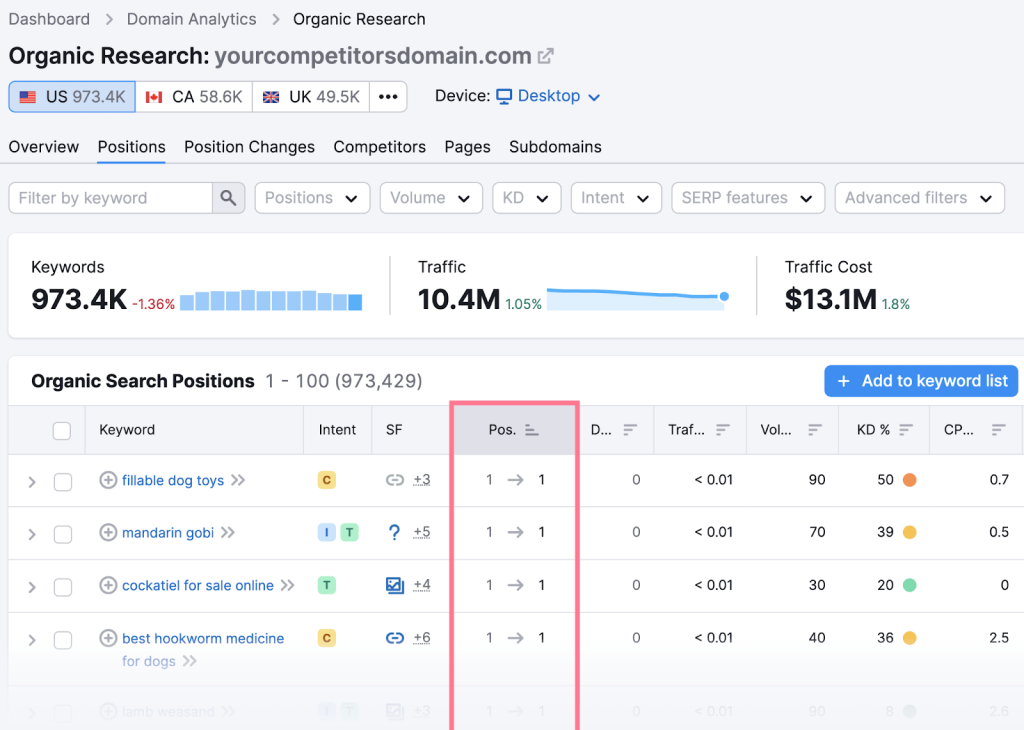
Analyze user behavior and engagement metrics.
Analyzing user behavior helps you determine how to improve user experience, and your search performance. Use tools like HotJar and Google Analytics to dig deep into how users interact with your website. They help you answer questions like:
- What is bringing visitors to your site?
- What makes users leave your site?
- What drives users to make a purchase?
Conclusion
SEO is changing, but it’s definitely not going away. Just as Andrea Volpini, SEO of WordLift, puts it:
“SEO is evolving beyond just answering questions. It now involves understanding user intent at a granular level, aligning content with complex needs, and ensuring its availability across all platforms – traditional search, AI agents, voice interactions, and digital assistants.”
With the strategies outlined above, your brand can boost visibility, drive real-time organic traffic, and ultimately convert visitors into paying customers.
